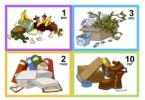Every person who has purchased a car wants their car to look good and have a great appearance. An indispensable part of the car are the wheels, which must be in good condition, so the question arises of how to decorate them with car hubcaps.
Car hubcaps perform several functions. This is an indispensable accessory for decorating a wheel. And most importantly, the caps protect the wheels from dust, stones and dirt. In this way they protect the entire brake system from rapid wear and premature aging.





It should be remembered that attaching the hubcaps is a labor-intensive job; you should treat it with special tolerance, since the appearance of the car will depend on it.
Today the topic of our meeting will be the installation of such a useful device as a car. It would seem like a simple element of the exterior, a beautiful piece of plastic, easy to install. But no, and some “lucky” people have probably already been able to verify this from their own experience. It turns out that if the installation of the caps is carried out incorrectly, they, even the highest quality ones, can crack, and the mounting latch may break. And joy after such an incident, of course, will not increase. So how to do everything right?
Install the spacer ring on the caps
So, let's start with the simplest thing - make sure that the radius of the hubcaps matches the radius of the wheels of your car. After this, we remove the caps one by one from the packaging and install a spacer ring in each. Its function is important - thanks to it, the wheel caps are held very firmly. On some manufacturers' hoods, spacer rings are installed on the conveyor. We will assume that you happened to buy wheel caps without installed rings. It should be noted that the fact of installed/uninstalled rings does not indicate (in our experience) the quality of the caps themselves.
The ring also needs to be installed correctly. Firstly, you need to pay attention that there is a bend on the ring itself. It should be aligned with the nipple valve. On some caps (most often the closed type) there is also a designated place in the plastic itself, which should be aligned with the nipple valve. If there is no such clearly indicated place, then the bend on the ring can be placed opposite any slot in the cap.
Now we would like to draw your attention to the next point - the ring is mounted in the cap in such a way that the bend on the ring faces the cap, and in no case vice versa.

The degree of bending of the ring in the valve area - what the bend should be, you can estimate from the following photograph:

Installation rules - first we place the valve under the nipple into the hole where we plan to release it, then we move the tab away and insert it and see that the spring is clearly fixed in the groove. Then we continue placing the spring in all the other legs.

We would like to draw your attention to the fact that the special support system is carried out on higher quality, factory-made caps, which have proven themselves both in Europe and throughout the world, and are becoming widespread in our countries. After we have installed the spring, we try to see how securely it is fixed, and see if it is in the grooves everywhere. After this, we can proceed to actually installing the wheel covers on the car.
Correct installation of wheel covers
We begin the installation with what has already been mentioned - we combine the bend under the valve with the valve itself and press the cap to the disk in this exact place.

Next, one by one, pressing the edge of the cap, insert each latch into the disk. The force should be sufficient to press the latch into the disk, but this must be done carefully so as not to damage the cap. Excessive pressure with your hands may cause it to burst. The same thing can happen if you press all the latches into the disk at the same time. Therefore, we snap each one in turn.

When you are sure that all the latches are in place, try, holding the opposite edges of the cap, turn it a little on the disk, and tug. That is, you need to make sure that the cap is in place and will not jump out on the road. By the way, drivers encounter this problem—loss of hubcaps—quite often. And in order to avoid it, you can use plastic clamps. Usually the average length of the clamp that will suit you is 30-35 cm, the width is usually 3.5-4.8 mm. Clamps come in black and white. They cost pennies, but their benefits are many times greater. Imagine yourself, you bought hubcaps and one flew away on the road. And that’s it, again you need to buy all four wheel covers.
By the way, you can order the website from the store caps individually— We try to help our clients out.
Here are all the instructions for you. Although many of our clients have long been advanced drivers, we hope that many will find it useful. In any case, we tried.
Domestic car owners are well familiar with such an accessory as wheel caps. They reliably protect the wheels from dirt, snow and stones and give the car an attractive and individual appearance. The choice of decorative caps today is quite wide. But there is one problem: sometimes they get lost. This is quite annoying, because as a result, as a rule, you have to replace the whole set. Therefore, a considerable number of discussions on automobile forums are devoted to the question of how to securely fasten the caps to the disks.

The simplest (and therefore quite popular) fastening of wheel covers is using latches. 6, 7 or 8 “legs” and a spacer ring included in the kit allow you to very quickly install the cap and just as quickly remove it if necessary. However, very often they are removed so simply that it happens spontaneously, on bumps and potholes, and sometimes just like that. In addition, hubcaps are often stolen in parking lots or courtyards. To solve this problem, car enthusiasts have come up with a number of tricks.

The most commonly used cable ties are plastic clamps. They can be easily found in any hardware store: black, white or transparent, 50-100 pieces per bag. Having installed the cap on the wheel and trying, if possible, to align its holes with the holes of the disk, grab a couple of ribs with clamps. Then trim the ends, then turn the clamps a little so that the clasps are hidden under the cap. If you choose the right color, this mount will be almost invisible.
However, if you try, you can make it completely hidden. To do this, you will have to pass the clamps under the stiffening ribs on the inside of the cap, leaving long “tails”, then install the cap in place, wrap the clamps around the ribs of the disk, tighten them and cut off the excess ends. Some people also like to use fishing line instead of clamps, threading it several times in a circle through the holes on the cap and disk, imitating sewing with a needle, and tying it in a knot. If it is necessary to remove the cap, the clamp or line is cut with wire cutters (which is a good idea to always have in the trunk for this purpose).

However, it should be noted that not all car owners approve of the methods described above. For example, some people believe that clamps do not look very aesthetically pleasing. In addition, in cold weather they become quite brittle and can crack. An alternative option is to secure the wheel covers with bolts. Of course, this requires drilling the cap (and sometimes the disc). But the fastening will be reliable, there is no doubt.
Which option to prefer is, of course, up to you to decide. But before installing the caps using any of the methods, take the time to thoroughly wash the discs. It also wouldn’t hurt to treat them with an anti-corrosion compound to protect the metal from moisture accumulating under the caps.
When buying a modern car, a person still experiences some inconveniences, which, meanwhile, are associated not with technical, but with visual and aesthetic characteristics. This happens because each of us strives to be different, and in this process a personal car is the object of constant design searches of the owner.
The simplest and least expensive way to effectively tune a base car model is to install wheel covers that will be the pride of the owner and the envy of others. Today the market is literally oversaturated with similar products of a wide variety of shapes, materials and colors. This naturally leads to the need to classify products, formulate certain selection criteria and installation methods.
Historical excursion
Just as the wheel was once invented, car hubcaps began their history and spread to the masses. The starting point can be considered the 30s of the twentieth century, namely, the release by Cadillac of the new V16 Victoria coupe. Then, for the first time in the history of the automotive industry, stainless steel wheels with full-size plugs installed on them were used. Previously, manufacturers used small central protective caps on wheels (boots), which protected the bearing assembly from contamination.
Attention! In the new Cadillac model, these functional elements began to play a decorative role for the first time, giving the wheels a refined and streamlined appearance. Thus, perhaps, tuning was born, and with it the industry of wheel plugs as self-sufficient products.
What are the caps for?
With the introduction of advanced technologies, such products are no longer used exclusively to protect wheel bearings. More precisely, they continue to perform this function, but it has become more complex and certainly not as lonely as at the dawn of its history.
Modern automobile wheel covers perform the following main functions:
- Decorative. This is perhaps the first thing that comes to mind when mentioning this product. Of course, such an element gives individuality and uniqueness to the “iron horse”. In addition, it perfectly hides all visual imperfections and defects of the wheel rim (chips, dents, corrosion spots, etc.).
- Protective. There is no escape from the origins - car wheels still rotate on wheel bearings, which are susceptible to clogging, corrosion, etc. Also on the outer side of the disc there are elements of a modern brake system (pads), which do not feel proper comfort when in open contact with the environment.
- Aerodynamic. A modern car is a vehicle whose streamlined body shape reduces movement resistance and fuel consumption. The plugs hide the protruding elements of the hubs and brake pads, improving aerodynamics and ensuring normal ventilation.
Kinds
Considering the variety of shapes and materials for the manufacture of car wheel plugs, they can be classified according to certain principles. The main one is the degree of ventilation of the disk space, which is provided by the shape of the wheel rim. Thus, caps are divided into open and closed, flat and inflated (convex).
Open are decorative disc plugs that have the maximum number of holes (for example, spoke-shaped) to ensure normal ventilation of the brake pads. Such products are preferable for installation on cars whose drivers prefer an aggressive, fast, sporty driving style. At the same time, the movement of the car is accompanied by constantly alternating acceleration and sharp braking, which can lead to overheating of the brake elements on the hubs without sufficient air cooling.

Closed ones, in turn, provide maximum concealment of disk defects, that is, they have a minimum number of holes. Such aesthetics have a downside - a low level of pad ventilation on the discs, which predisposes to a more measured, calm or economical driving style.
Both plugs can be flat (all structural elements are located approximately in the same plane) and inflated (individual structural elements of the cap are located in a plane protruding beyond the wheel dimensions). Obviously, the former are more practical, since contact with various road elements (curbs) is absorbed by the tire size.
Classification by material
Important! A separate type classification is carried out according to the materials from which the disk plugs are made. Most often on the market you can find products made of plastic, metal, rubber.
Plastic caps are made from plastic materials using injection molding technology. For this purpose, plastics such as ABS (polymers based on acrylonitrile, butadiene, styrene), polystyrene with impact-resistant characteristics (for example, UPM 0612 or PSM 508) are used. The advantage of such decorative wheel covers is the huge choice of colors and surface structure (matte or glossy). But they have an obvious drawback - low mechanical strength and fragility, especially at low temperatures.

The problem of fragility was solved in the so-called flexible wheel covers. An example is SKS/SJS products. They are made from ABS plastic, but during the casting process special additives based on nylon are added to the mass. This gives the product flexibility, which means it increases resistance to mechanical and weather destructive factors.

Separately, a group of rubber wheel caps should be highlighted. They got their name due to their particularly high flexibility, which makes their material look like rubber. In fact, these are the same plastic wheel caps, only thermoplastic elastomers (TPE-S, TPE-U, TPE-V, etc.) are used for their manufacture. They are attached with standard bolts to the hub. If desired, you can safely bend the rim of the product to the side without any consequences for its condition.

Metal wheel caps can be considered a classic. They have the highest mechanical strength and perfectly protect discs from impacts. Such products have more reliable fastening using hub bolts. But, with all this, metal plugs are not without obvious disadvantages: heavy weight, corrosion tendency, deformation under mechanical stress, higher cost.

Types of decorative caps
The classification can be continued by including purely decorative species. As you can imagine from the name of the subgroup, their main function is aesthetic, that is, creating an attractive appearance of the car.

Chrome wheel caps are decorative products that got their name because of the characteristic mirror coating that imitates a metallized layer of chrome on the surface. They are distinguished by a very solemn or even pretentious appearance, but in the case of low-quality, non-original products, the “chrome plating” will soon begin to peel off, exposing all the ins and outs of the decorative and functional disk plug.
Important! Colored caps allow you to choose a range in accordance with the color of the car body, but the paint requires quite a careful attitude.
Rotating wheel covers allow you to realize a very interesting decorative effect: while the car is moving, the inside of the product rotates in the opposite direction with respect to the wheel. This is possible thanks to the composite design of the disk plug, which has a rim and a core.

Criterias of choice
When choosing car hubcaps, you should take into account some important criteria, which subsequently affect reliable and trouble-free operation (or its possibility at all):
- size. In this case, we mean the landing diameter, which relates to the standard size of the wheel disk. In catalog cards this parameter is indicated, for example, R14, which indicates that such products should be used on wheels with a diameter of 14̋";
- form. This parameter determines the appearance of the decorative plug, that is, its aesthetic component;
- material. The criterion determines the performance characteristics of the product;
- fixation method. This parameter determines how the cap will be attached to the wheel rim.
How to install
The installation method for wheel disk plugs is based on their design, or more precisely on the fixation principle implemented in it:

Wheel covers are one of the most affordable options for external car tuning, and at the same time are functional enough to extend the life of rims and wheel hubs.
Video of installing wheel covers:



